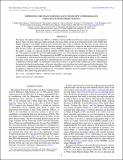| dc.contributor.author | Zingarelli, J. Chris | |
| dc.contributor.author | Pearce, Eric | |
| dc.contributor.author | Lambour, Richard L. | |
| dc.contributor.author | Blake, T. | |
| dc.contributor.author | Peterson, Curtis J. R. | |
| dc.contributor.author | Cain, Stephen | |
| dc.date.accessioned | 2015-01-16T16:23:03Z | |
| dc.date.available | 2015-01-16T16:23:03Z | |
| dc.date.issued | 2014-05 | |
| dc.date.submitted | 2013-03 | |
| dc.identifier.issn | 0004-6256 | |
| dc.identifier.issn | 1538-3881 | |
| dc.identifier.uri | http://hdl.handle.net/1721.1/92938 | |
| dc.description.abstract | The Space Surveillance Telescope (SST) is a Defense Advanced Research Projects Agency program designed to detect objects in space like near Earth asteroids and space debris in the geosynchronous Earth orbit (GEO) belt. Binary hypothesis test (BHT) methods have historically been used to facilitate the detection of new objects in space. In this paper a multi-hypothesis detection strategy is introduced to improve the detection performance of SST. In this context, the multi-hypothesis testing (MHT) determines if an unresolvable point source is in either the center, a corner, or a side of a pixel in contrast to BHT, which only tests whether an object is in the pixel or not. The images recorded by SST are undersampled such as to cause aliasing, which degrades the performance of traditional detection schemes. The equations for the MHT are derived in terms of signal-to-noise ratio (S/N), which is computed by subtracting the background light level around the pixel being tested and dividing by the standard deviation of the noise. A new method for determining the local noise statistics that rejects outliers is introduced in combination with the MHT. An experiment using observations of a known GEO satellite are used to demonstrate the improved detection performance of the new algorithm over algorithms previously reported in the literature. The results show a significant improvement in the probability of detection by as much as 50% over existing algorithms. In addition to detection, the S/N results prove to be linearly related to the least-squares estimates of point source irradiance, thus improving photometric accuracy. | en_US |
| dc.description.sponsorship | United States. Defense Advanced Research Projects Agency | en_US |
| dc.language.iso | en_US | |
| dc.publisher | Institute of Physics/American Astronomical Society | en_US |
| dc.relation.isversionof | http://dx.doi.org/10.1088/0004-6256/147/5/111 | en_US |
| dc.rights | Article is made available in accordance with the publisher's policy and may be subject to US copyright law. Please refer to the publisher's site for terms of use. | en_US |
| dc.source | American Astronomical Society | en_US |
| dc.title | IMPROVING THE SPACE SURVEILLANCE TELESCOPE'S PERFORMANCE USING MULTI-HYPOTHESIS TESTING | en_US |
| dc.type | Article | en_US |
| dc.identifier.citation | Chris Zingarelli, J., Eric Pearce, Richard Lambour, Travis Blake, Curtis J. R. Peterson, and Stephen Cain. “IMPROVING THE SPACE SURVEILLANCE TELESCOPE’S PERFORMANCE USING MULTI-HYPOTHESIS TESTING.” The Astronomical Journal 147, no. 5 (April 10, 2014): 111. © 2014 American Astronomical Society. | en_US |
| dc.contributor.department | Lincoln Laboratory | en_US |
| dc.contributor.mitauthor | Pearce, Eric | en_US |
| dc.contributor.mitauthor | Lambour, Richard L. | en_US |
| dc.relation.journal | Astronomical Journal | en_US |
| dc.eprint.version | Final published version | en_US |
| dc.type.uri | http://purl.org/eprint/type/JournalArticle | en_US |
| eprint.status | http://purl.org/eprint/status/PeerReviewed | en_US |
| dspace.orderedauthors | Chris Zingarelli, J.; Pearce, Eric; Lambour, Richard; Blake, Travis; Peterson, Curtis J. R.; Cain, Stephen | en_US |
| mit.license | PUBLISHER_POLICY | en_US |
| mit.metadata.status | Complete | |
